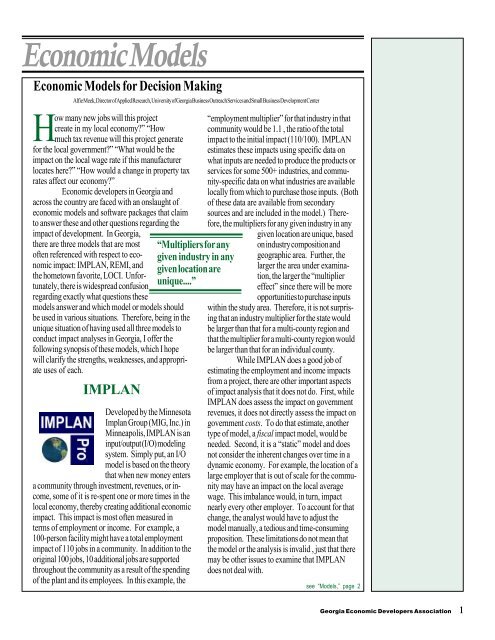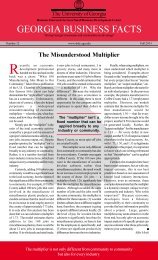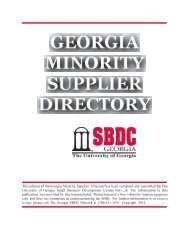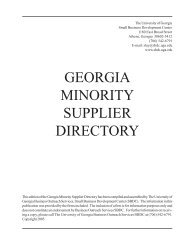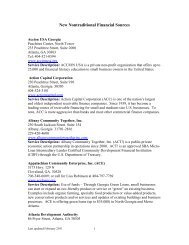Economic Models - Georgia Small Business Development Center
Economic Models - Georgia Small Business Development Center
Economic Models - Georgia Small Business Development Center
You also want an ePaper? Increase the reach of your titles
YUMPU automatically turns print PDFs into web optimized ePapers that Google loves.
<strong>Economic</strong> <strong>Models</strong><strong>Economic</strong> <strong>Models</strong> for Decision MakingAlfie Meek, Director of Applied Research, University of <strong>Georgia</strong> <strong>Business</strong> Outreach Services and <strong>Small</strong> <strong>Business</strong> <strong>Development</strong> <strong>Center</strong>How many new jobs will this projectcreate in my local economy?” “Howmuch tax revenue will this project generatefor the local government?” “What would be theimpact on the local wage rate if this manufacturerlocates here?” “How would a change in property taxrates affect our economy?”<strong>Economic</strong> developers in <strong>Georgia</strong> andacross the country are faced with an onslaught ofeconomic models and software packages that claimto answer these and other questions regarding theimpact of development. In <strong>Georgia</strong>,there are three models that are mostoften referenced with respect to economicimpact: IMPLAN, REMI, andthe hometown favorite, LOCI. Unfortunately,there is widespread confusionregarding exactly what questions thesemodels answer and which model or models shouldbe used in various situations. Therefore, being in theunique situation of having used all three models toconduct impact analyses in <strong>Georgia</strong>, I offer thefollowing synopsis of these models, which I hopewill clarify the strengths, weaknesses, and appropriateuses of each.IMPLANDeveloped by the MinnesotaImplan Group (MIG, Inc.) inMinneapolis, IMPLAN is aninput/output (I/O) modelingsystem. Simply put, an I/Omodel is based on the theorythat when new money entersa community through investment, revenues, or income,some of it is re-spent one or more times in thelocal economy, thereby creating additional economicimpact. This impact is most often measured interms of employment or income. For example, a100-person facility might have a total employmentimpact of 110 jobs in a community. In addition to theoriginal 100 jobs, 10 additional jobs are supportedthroughout the community as a result of the spendingof the plant and its employees. In this example, the“Multipliers for anygiven industry in anygiven location areunique....”“employment multiplier” for that industry in thatcommunity would be 1.1 , the ratio of the totalimpact to the initial impact (110/100). IMPLANestimates these impacts using specific data onwhat inputs are needed to produce the products orservices for some 500+ industries, and community-specificdata on what industries are availablelocally from which to purchase those inputs. (Bothof these data are available from secondarysources and are included in the model.) Therefore,the multipliers for any given industry in anygiven location are unique, basedon industry composition andgeographic area. Further, thelarger the area under examination,the larger the “multipliereffect” since there will be moreopportunities to purchase inputswithin the study area. Therefore, it is not surprisingthat an industry multiplier for the state wouldbe larger than that for a multi-county region andthat the multiplier for a multi-county region wouldbe larger than that for an individual county.While IMPLAN does a good job ofestimating the employment and income impactsfrom a project, there are other important aspectsof impact analysis that it does not do. First, whileIMPLAN does assess the impact on governmentrevenues, it does not directly assess the impact ongovernment costs. To do that estimate, anothertype of model, a fiscal impact model, would beneeded. Second, it is a “static” model and doesnot consider the inherent changes over time in adynamic economy. For example, the location of alarge employer that is out of scale for the communitymay have an impact on the local averagewage. This imbalance would, in turn, impactnearly every other employer. To account for thatchange, the analyst would have to adjust themodel manually, a tedious and time-consumingproposition. These limitations do not mean thatthe model or the analysis is invalid , just that theremay be other issues to examine that IMPLANdoes not deal with.see “<strong>Models</strong>,” page 2<strong>Georgia</strong> <strong>Economic</strong> Developers Association 1


